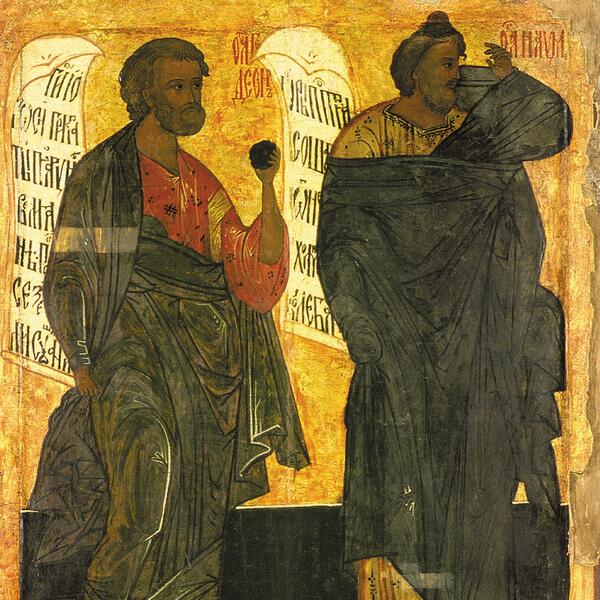This icon with full-length images of Prophets Gideon and Nahum belongs to the oldest surviving Prophets tier in Yaroslavl. According to their iconographic tradition, each image in this icon was based on the description in the Bible and the canon. Depending on the age, these could be beardless youths, men in the prime of life, or gray-bearded old men. The kings were always portrayed wearing red robes and wreaths, and high priests were depicted in short ephods.
Prophet Gideon was the fifth judge of Israel which meant that in fact, he was the leader of the country. By the time he came to power, Israel “was greatly impoverished” (Judges 6:6), and the moral decline resulted in the political divide and frequent raids of eastern peoples on the lands of Israel. Gideon’s two elder brothers were killed in battle, while he, “the man of valor”, was destined to defeat the enemy’s forces and drive them away from the land of Canaan.
The night before the battle against the Midianites, Gideon asked God to give him proof of his will. He left a fleece on the ground and in the morning, he found it covered in due while the surrounding ground was dry. This was the sign that Israel would be saved. In the New Testament, the wet fleece also became regarded as the foreshadowing of the Annunciation and the Nativity of Jesus and one of the symbols of the Mother of God.
In gratitude for the victory, the Israelites invited Gideon to become their king, but he refused to violate the Law of Moses and remained a judge. Apart from defeating the Midianites, he was famous for destroying the altar of a pagan deity. Because of that he was given the name Jerubbaal or contending Baal.
Prophet Nahum came from Alqosh, northern Israel, and preached between 727 and 698 BC, during the reign of Hezekiah. The Book of Nahum includes three chapters and provides an informative and vivid description of the political, religious, and moral situation in Israel and partly Assyria, as well as the dreadful prophecy of the destruction of Nineveh. The image of Nahum was rarely included in the Prophets tier. In various scenes, different texts were chosen to be depicted on his scroll.
Prophet Gideon was the fifth judge of Israel which meant that in fact, he was the leader of the country. By the time he came to power, Israel “was greatly impoverished” (Judges 6:6), and the moral decline resulted in the political divide and frequent raids of eastern peoples on the lands of Israel. Gideon’s two elder brothers were killed in battle, while he, “the man of valor”, was destined to defeat the enemy’s forces and drive them away from the land of Canaan.
The night before the battle against the Midianites, Gideon asked God to give him proof of his will. He left a fleece on the ground and in the morning, he found it covered in due while the surrounding ground was dry. This was the sign that Israel would be saved. In the New Testament, the wet fleece also became regarded as the foreshadowing of the Annunciation and the Nativity of Jesus and one of the symbols of the Mother of God.
In gratitude for the victory, the Israelites invited Gideon to become their king, but he refused to violate the Law of Moses and remained a judge. Apart from defeating the Midianites, he was famous for destroying the altar of a pagan deity. Because of that he was given the name Jerubbaal or contending Baal.
Prophet Nahum came from Alqosh, northern Israel, and preached between 727 and 698 BC, during the reign of Hezekiah. The Book of Nahum includes three chapters and provides an informative and vivid description of the political, religious, and moral situation in Israel and partly Assyria, as well as the dreadful prophecy of the destruction of Nineveh. The image of Nahum was rarely included in the Prophets tier. In various scenes, different texts were chosen to be depicted on his scroll.



